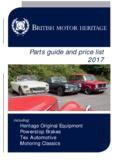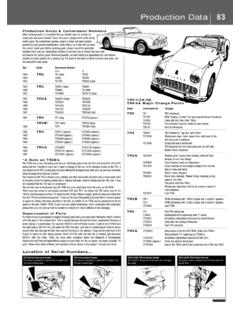Transcription of Refitting New Rear Hubs to the TR6 A - CPTC
1 Copyright Ron Weber, 2011 Refitting New rear hubs to the TR6 Ron Weber Central PA triumph Club 3/05/2011 What follows is an overview of the steps needed to swap out the stock TR6 rear hubs and replace them with new, improved design Good Parts hubs . Before going into the gory details of the exchange, and it really isn t that bad, let me level set everyone on what led me to this. Since finishing my 71 TR6 rebuild in 2007 (wow, time flies in a triumph !) I ve had an annoying harmonic vibration occurs between 50 & 55mph. When this occurs, the whole car suddenly shakes through this speed range but diminishes when I go beyond 55. I discussed this with fellow club members, consulted the all-knowing online oracle known as the British Car Forum (BCF) and came to the conclusion that it must be the steel wheels. As we re all aware, they re well known for being installed factory-fresh out of round and having cranked flanges as a result of too many encounters with curbs.
2 After multiple rounds of buying, swapping and rebalancing steel wheels, I still saw no resulting improvement in the vibration. Suddenly, it became apparent to me I was just buying and painting some really nice looking wheels to add to my growing collection. The engineer in me decided to eliminate a variable to help determine the root problem so after much deliberation and research, I ordered a set of new Minilites thinking this would eliminate all possibility of vibration coming from the wheels. (OK, in reality, I really always wanted a set and just needed a tangible excuse to leverage the household checking account). I had high hopes for the new aluminum wheels. Sadly, I discovered shortly after mounting the tires and balancing them that it didn t help- the vibration was still there. The one positive outcome from this is that while I still had the vibration, at least now I have a really cool looking set of wheels! This takes us up to the topic of this article.
3 There were very few things left that could cause the vibration. Naturally, I turned my focus to the next expensive thing- the hubs . I jacked the car up and discovered that I could grab the right rear tire and wiggle it ever so slightly. The left was tight with no discernable movement. Hmm, a worn hub be the cause of the vibration? One way to find out-- replace them! Ok, now that the decision was made to tackle the hubs , I had another decision to make: rebuild the hubs myself, order a rebuilt set from TRF, or get a set of Good Parts hubs . Although it would be the least expensive route at roughly $100 per hub, I really didn t want to mess with making the tools needed to rebuild the existing hubs and run the risk of completely buggering them up. That left two options: buy TRF rebuilt hubs at $300 a piece or buy Good Parts hubs at $349 each. Both require PA sales tax and with TRF s shipping costs, it was just about a wash from a cost standpoint.
4 Given that it is a 45 min drive to Good s garage, I opted for the Good Parts hubs after reading positive comments on BCF. These hubs are much improved over stock hubs and utilize modern materials and feature double row angular contact sealed ball bearings that, if required, are easily replaced. Copyright Ron Weber, 2011 After picking up the hubs from Richard Good s garage, I brought them home and unwrapped them. These hubs are works of art! They re beautifully machined and finished to the point it is a shame to hide them in a trailing arm housing. Well, ya gotta do what ya gotta do so here s how to replace Removing the old hubs wasn t much of a problem. Jack-up and support the car using jack stands. Remove the rear wheels and put the nuts where you can easily find them later. The drums are held on to the hub using two small slotted screws in the drum face so remove these. If the drum is loose at this point, it may just pull off if there isn t a ledge worn in it from the shoes.
5 If there is a ledge, simply back off the brake adjuster a bit to pull back the shoes allowing them to clear the ledge. There is a slight chance the drum may be rusted to the hub- if this is the case, some penetrating oil and a couple raps with a soft mallet is usually enough to break it loose. When the drum is off, the hub is visible. It s pretty easy to remove the hub at this point. Line up the holes in the hub to expose the nuts that retain the hub to the trailing arm and use a socket on an extension to remove each pair of nuts. Throw the nuts out since they shouldn t be reused. Before pulling the hub out, use a pair of side cutters to clip the wire wrap that secures the rubber inner shaft boot to the outer shaft boot. Copyright Ron Weber, 2011 Next, pull the entire hub assembly out through the trailing arm. At this point you ll have the hub assembly with the shaft (I guess that makes it a quarter shaft ). Using a pair of ring clip pliers, remove the two ring clips where the hub connects to the universal joint.
6 Depending on when you last touched the universal joint, it may be easy to tap out the bearing cups or you may end up needing to press them out with a hydraulic press. I used a socket that was just slightly smaller than the cup diameter to tap out the universal joints. If they ve been in there long enough to need a press, this may be a good opportunity to replace them with new ones. The next step is to install the stub shaft and universal joint on the new hub. Position the existing universal cross shaft in the new hub yoke and use a socket and small hammer to tap each of the two cups back onto the cross shaft ends. Take care not to displace any of the needle bearing rollers in the cups while you re reassembling and, most importantly, do this on a clean surface. Any grit, dust or debris will cause the joint to pre-maturely self-destruct. Copyright Ron Weber, 2011 The hub is now ready for re-installation. Grease the spline and universal joint now while everything is accessible.
7 It s probably not a bad idea to grease the inner shaft universal joints too at this time. Slide the hub back into the trailing arm making sure to align the inner and outer splined shaft halves. There is a large flat on the spline to properly orient everything so make sure to take note of where it is before you start and save yourself some frustration. Use new 5/16 Nylock nuts (that Richard thoughtfully includes) to secure the hub to the trailing arm using a torque wrench set to between 12-16 ft-lbs. Make sure the two boot halves overlap and install a new wrap-wire on the outer rubber boot end to secure the two halves. Reinstall the brake drum, mount the tire, and readjust the brakes. Repeat the process on the other side and you re now ready for the road again! In summary, the test drive proved that this was the source of my vibration problem (thankfully!). In all, it took me about 2 hours to do both sides and it was a pretty simple project.
8 One caveat: keep in mind my universal joint bearing cups came out relatively easily so if it s been a while since you last touched the universal joints, plan on spending a little more time wrestling with the joints. Footnote: It is worth mentioning that, in some instances, the hub attachment studs that are located in the trailing arm may be stripped due to abuse or over-torturing. Good Parts offers a hub variation that uses coarse threaded 3/8 studs for attachment. Since coarse threads are recommended in aluminum anyway, replacing them is not an altogether bad thing and would minimize the possibility of ever having stud hole stripping problems again. It does however require drilling and re-tapping the trailing arm hub holes to accommodate the larger studs.




